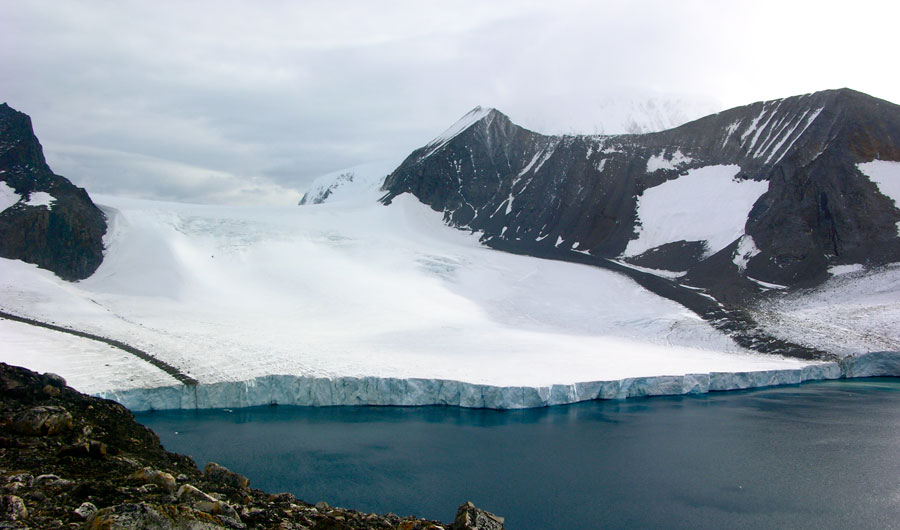Can We Hold Back the Glaciers?
(Inside Science) -- A major threat from climate change is rising sea levels, and much of that threat comes from glaciers melting into the oceans. By the end of the century, sea levels are predicted to be a meter higher, causing frequent floods of coastal cities.
So a group of glaciologists is proposing a radical solution to buy us more time to reduce carbon emissions and adapt to climate change. They are proposing huge engineering projects to act as barriers, holding back the glaciers, slowing their melt and staving off the rising tide. The idea is explored in a commentary published last month in the journal Nature. John Moore, a glaciologist at Beijing Normal University in China, and his colleagues suggest three ways that the glaciers in Greenland and Antarctica contributing the most to sea level rise could be stopped in their tracks.
“A lot of sea level rise is through narrow but fast-flowing glaciers that are retreating because of warming oceans, not air,” Moore said. “So we looked for ways to slow the glaciers down, or limit their contact with warm water.”
The authors suggested building huge underwater berms along the sea floor in front of the glaciers to keep warmer water away from their base, constructing artificial islands to pin the glaciers in place and prevent them from breaking up, and drilling down to the thin layer of wet sediment the glacier is sliding on to remove or freeze the water and slow its advance.
Moore admits that engineering projects on this scale, in such remote and inhospitable locations, strike most people as crazy at first. “We've been thinking about this for two years but were careful about discussing it with our colleagues because we didn't want to be thought of as Bond villains,” he said.
But Moore and his colleagues have spent years thinking through the proposals, and they believe the glacier projects would be comparable in terms of cost and engineering complexity to other major projects around the world, such as the Panama Canal, the Three Gorges Dam in China, or Hong Kong's new airport built on an artificial island. And given that sea walls and coastal flood defenses cost tens of billions of dollars a year to build and maintain, glacier geoengineering is cost-competitive with other mitigation options. “There's talk of building walls around all coasts, so why not tackle it at the source?” Moore said.
It could work, according to Gwenn Flowers, a glaciologist at Simon Fraser University in Vancouver, Canada who was not involved in the research. She said that given what we know about ice discharge from glaciers, the proposed mechanisms to slow it down are sensible. “They're not coming out of nowhere saying things that don't make sense,” she said. “The three mechanisms imitate nature in slowing ice discharge to the sea.”
And the three glaciers they suggest focusing on -- the Jakobshavn glacier in western Greenland, and the Pine Island and Thwaites glaciers in West Antarctica -- are good choices. “These places are contributing a lot of ice to the ocean,” she said. But she warns that if over time other glaciers begin to contribute more, the whole process would have to be repeated.
From an engineering perspective, glacier geoengineering would be a “tremendous challenge,” said Bilal Ayyub, a civil engineer at the University of Maryland and head of the Infrastructure Resilience Division of the American Society of Civil Engineers. “It's a good concept, but more thinking is needed about the design and construction feasibility,” he said.
In particular, the artificial islands would be subject to huge pressures from the ice bearing down on them. “The pressure would be just horrendous, like nothing we've seen before in engineering,” he said. Even the pressure from water on the largest dams wouldn't come close, and those dams still struggle to keep the water in place. “With dams or retaining walls we need to find ways to release the pressure. There's no release here.”
The underwater berms would face their own construction challenges, he added, especially at the depths required. “Placing concrete at depth is not trivial,” he said. “I don't know what technology would be used.”
Beyond those technical questions, there is also the matter of whether the projects would actually be effective, what the environmental impact would be, and who would actually pay for them, added Ayyub.
Moore agrees that many of the details remain to be worked out, but he feels it is an avenue worth exploring. “Even under the Paris agreement, we're expecting a 5 meter rise over the next 200 years,” he said. “So I think we should take a serious look at geoengineering.”
And Flowers points out that smaller attempts to preserve glaciers at ski hills by wrapping them in blankets seemed strange a decade ago but are now done routinely each spring. “We've gotten used to small-scale geoengineering. Now maybe it's time to move on to the next level,” she said. “Maybe it won't seem as unusual 10 or 20 years down the road.”


